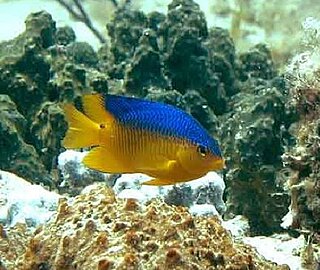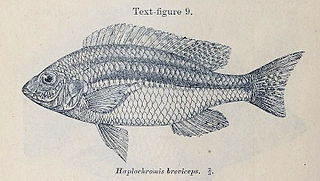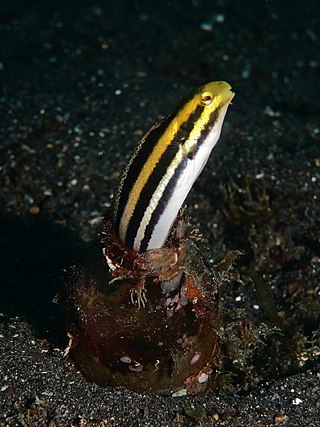
The sugar glider is a small, omnivorous, arboreal, and nocturnal gliding possum. The common name refers to its predilection for sugary foods such as sap and nectar and its ability to glide through the air, much like a flying squirrel. They have very similar habits and appearance to the flying squirrel, despite not being closely related—an example of convergent evolution. The scientific name, Petaurus breviceps, translates from Latin as "short-headed rope-dancer", a reference to their canopy acrobatics.

Pomacentridae is a family of ray-finned fish, comprising the damselfishes and clownfishes. This family were formerly placed in the order Perciformes but are now regarded as being incertae sedis in the subseries Ovalentaria in the clade Percomorpha. They are primarily marine, while a few species inhabit freshwater and brackish environments. They are noted for their hardy constitutions and territoriality. Many are brightly colored, so they are popular in aquaria.

The pygmy sperm whale is one of two extant species in the family Kogiidae in the sperm whale superfamily. They are not often sighted at sea, and most of what is known about them comes from the examination of stranded specimens.

Amblypomacentrus is a small genus of fish in the family Pomacentridae. As of the year 2000, there are 3 species.

Cran's bully is a species of fish in the family Eleotridae endemic to New Zealand, where it is only found in fresh waters. This species can reach a length of 9 cm (3.5 in).

Breviceps adspersus, also known as common rain frog, bushveld rain frog, and many other vernacular names, is a species of frog in the family Brevicipitidae. It is found in Southern Africa, in Angola, Democratic Republic of the Congo, Namibia, Botswana, Zambia, Zimbabwe, South Africa, Eswatini, and Mozambique.

Bilbo's rain frog is an amphibian species in the family Brevicipitidae, endemic to South Africa. The frog was named after Bilbo Baggins, the main character from The Hobbit by J.R.R Tolkien. The frog was named as such because the scientist who discovered it used to read the novel to his children. Its natural habitats are temperate grasslands and edges of wood plantations, wherein it spends most of its time in its burrow. The species is threatened by construction, maintenance of roads, silviculture, general habitat degradation/habitat loss, and by road traffic. As a result, it is listed as Near Threatened in the IUCN Red List of Threatened Species.

Breviceps fuscus, also known as black rain frog, plain rain frog, brown short-headed frog, and Tsitsikamma rainfrog, is a species of frogs in the family Brevicipitidae. It is endemic to the southern coast of South Africa.

The cape rain frog or giant rain frog is a species of frog in the family Brevicipitidae. Adults grow up to 45 mm in length. It was the first African frog species to be scientifically described by Carl Linnaeus in 1758, under the name Rana gibbosa. It is the most common and largest of rain frogs. The name "rain frog" that is applied to the genus refers to a belief that these frogs bring rain.

The desert rain frog, web-footed rain frog, or Boulenger's short-headed frog is a species of frog in the family Brevicipitidae. It is found in Namibia and South Africa. Its natural habitat is the narrow strip of sandy shores between the sea and the sand dunes. It is threatened by habitat loss by such factors as mining and tourism.

The forest rain frog is a species of frog in the family Brevicipitidae. It is endemic to Limpopo, South Africa. Two allopatric subspecies are recognized: the nominate one, Breviceps sylvestris sylvestris, and Breviceps sylvestris taeniatusPoynton, 1963 from near Soutpansberg. Its natural habitats are temperate forests, temperate grassland, and rural gardens. It is threatened by habitat loss.

The knobby seahorse, also known as the short-headed seahorse or short-snouted seahorse, is a species of marine fish of the family Syngnathidae. It inhabits coastal waters in southwestern and southeastern Australia, from Gregory to Bremer Bay, and from Denial Bay to Newcastle.

Nyassachromis breviceps is a species of cichlid endemic to Lake Malawi where it is only found in the southern part of the lake. It prefers areas with sandy substrates but needs a supply of small pebbles for nest building. This species can reach a length of 15.4 centimetres (6.1 in) TL. This species was last observed in Lake Malawi in 1997 and is thought that it may be extinct, caused by overexploitation by artisanal fishermen.

Baird's pocket gopher or the Louisiana pocket gopher is a species of pocket gopher that is native to the southern United States. In total, there are three almost identical species of eastern pocket gopher; Geomys attwateri, G. bursarius, and G. breviceps. G. breviceps is larger in size, G. attwateri is medium-sized and G. bursarius is a bit smaller. Other than by size variation they are not identifiable by external features. Baird's pocket gophers are small rodents with most of their weight on the top half of their bodies.
Schistura breviceps is a species of ray-finned fish in the stone loach genus Schistura. It has only been recorded in the drainage system of the Mae Nam Kok, a tributary of the Mekong in northern Thailand and Myanmar. It has been seen in streams with a moderate flow over gravel or stone stream beds.
The shorthead barb is a species of ray-finned fish in the genus Enteromius from the catchments of the Longo and Cunene Rivers in Namibia and Angola.
Smallmouth redhorse is a species of ray-finned fish in the genus Moxostoma.

Petroscirtes breviceps, the striped poison-fang blenny mimic, striped fangblenny mimic, short-head sabretooth blenny, short-headed blenny, sabretooth blenny, or the black-banded blenny, is a species of combtooth blenny found in coral reefs in the western Pacific and Indian ocean. This species reaches a length of 11 centimetres (4.3 in) SL.
Amblypomacentrus clarus, the Bangaii damselfish is a species of ray-finned fish, a damselfish from the family Pomacentridae'. It is found in south-east Asia with records from Indonesia, the Philippines and Cambodia. It is similar to Amblypomacentrus breviceps, with which it is sympatric but it is separated by the patten of the body with the three dark bars being more contarsed than in A. breviceps, and it does not have the rows of light blue spots on its flanks and a diffuse yellow colouration on the lower body also frequently shown by A. breviceps.
Amblypomacentrus vietnamicus is a species of ray-finned fish from the family Pomacentridae, the damselfishes and clownfishes. It was described in 2004 from the South China Sea off Vietnam, It differs from its congeners in lacking the dark bars seen in Amblypomacentrus breviceps and A. clarus.
















